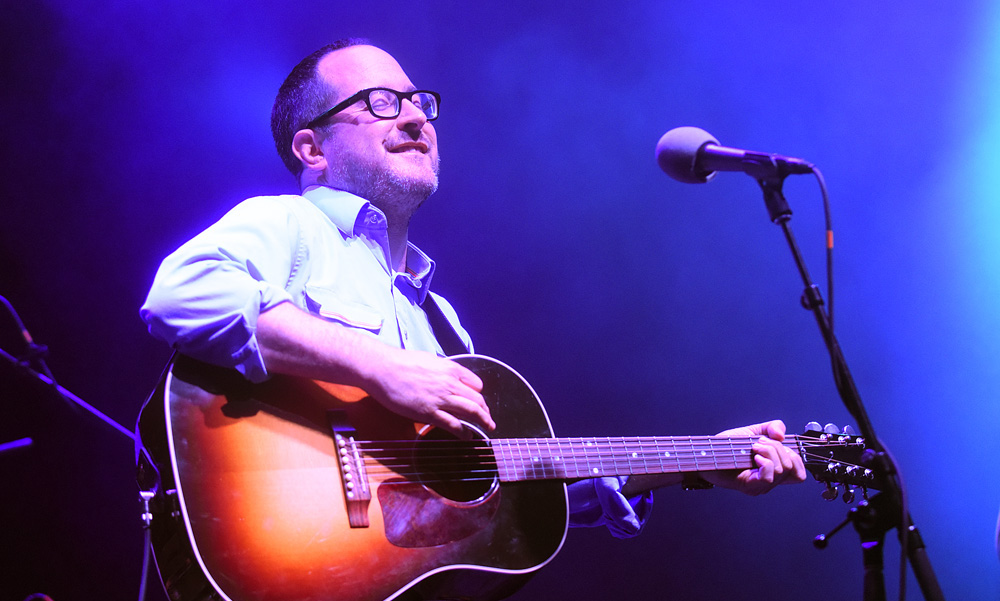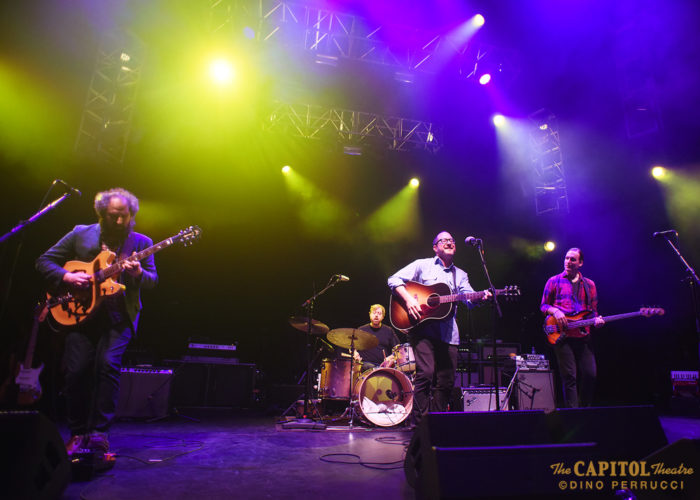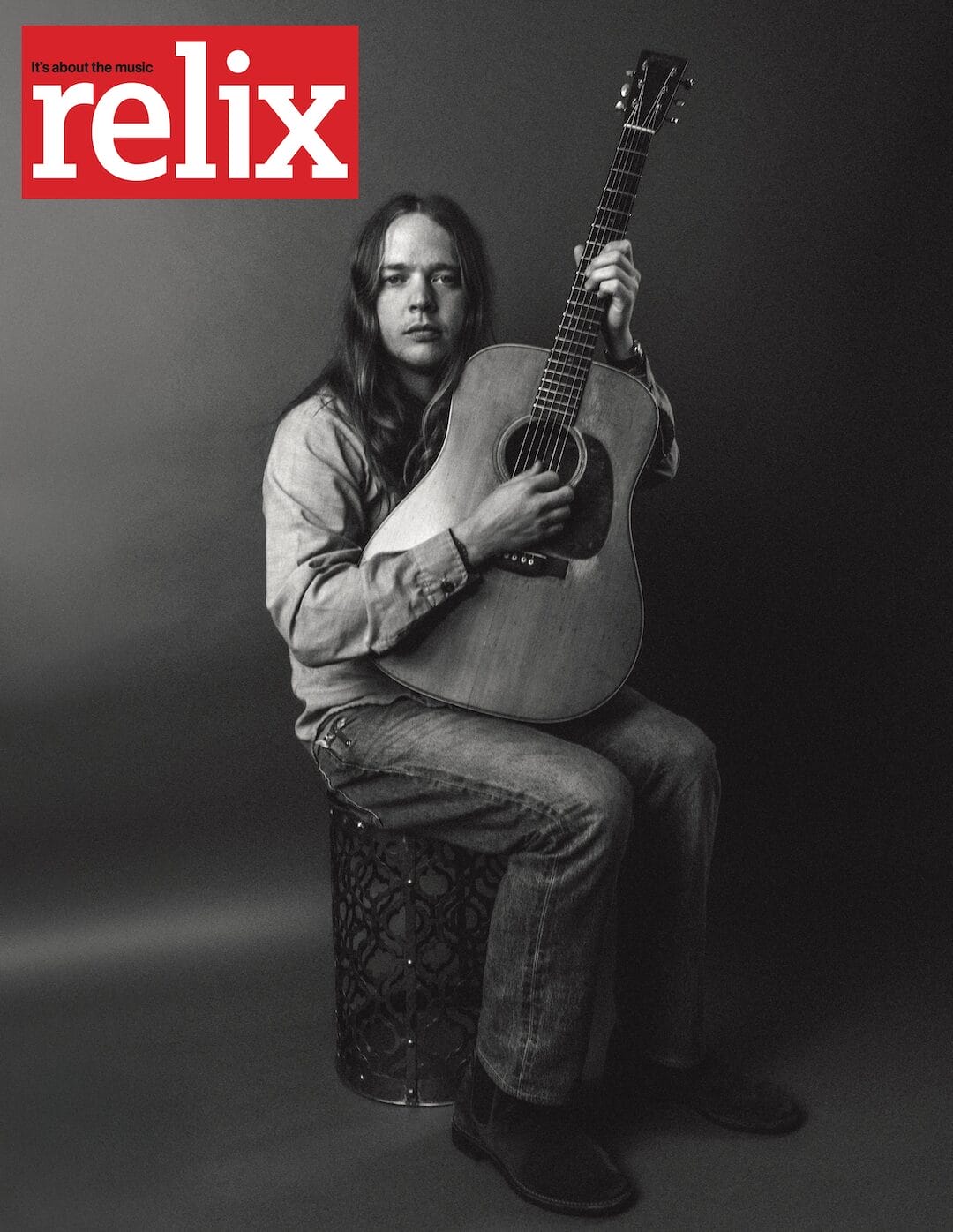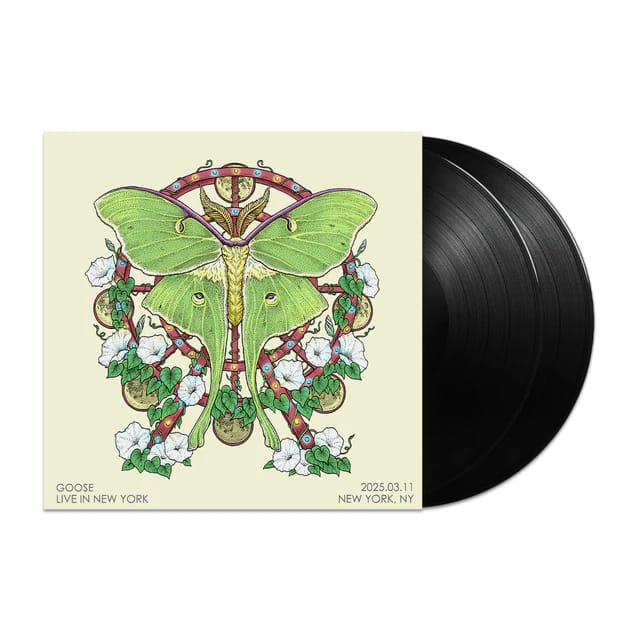Creative Adulting: A Conversation with Craig Finn, Joe Russo and Josh Kaufman

photo by Dino Perrucci
The Hold Steady frontman has found a new way to explore these confusing modern times with the help of two pals who possess some serious Grateful Dead cred.
Josh Kaufman’s studio is located on the fourth floor of a mixed-use complex in the DUMBO neighborhood of Brooklyn. Though the space is cozy and mostly nondescript from the outside, it’s become something of a Grand Central for Kaufman’s extended musical network, thanks to the multi-instrumentalist and producer’s work with modern troubadours like Hiss Golden Messenger, Josh Ritter, Dawn Landes, Eric D. Johnson and his former psych-rock band, Yellowbirds. Just a day earlier, Antibalas trumpeter Jordan McLean dropped off some new records.
The building’s basement is also home to Saltlands, an influential commercial recording community and, when Kaufman rented a room on that floor, he hosted the East Coast rehearsals for The National’s cross-genre Bridge Session collaboration with Bob Weir. In certain ways, the resulting performance served as the Big Bang for the indie world’s current Dead renaissance, paving the way for both the Day of the Dead project and Weir’s own Blue Mountain LP, which Kaufman produced.
On this weekday morning, Kaufman is hosting The Hold Steady frontman Craig Finn and drummer Joe Russo, whose posts in Furthur and Joe Russo’s Almost Dead have turned him into one of the most recognizable faces on the jamband circuit during the past decade. The three musicians have gathered to talk about their work on Finn’s new solo release, I Need a New War, their third collaboration following 2015’s Faith in the Future and 2017’s We All Want the Same Things. All three releases were recorded at Woodstock, N.Y.’s The Isokon and take a close look at communication and connection in the complex modern era.
Given how deeply ingrained all three players are in their local New York communities—regularly showing up at neighborhood gigs, sometimes to watch, often to play—it’s surprising that it took the musicians so long to find themselves in the studio together.
Finn is also currently pondering the “jambandification” of The Hold Steady. Recently, they’ve been focusing on multi-night runs in cities where they can stretch out their catalog. He chuckles at the thought of his fans taking over various downtown areas Deadhead style during those destination weekends.
As many of his peers have decamped to Los Angeles or Nashville in recent years, Finn has assembled a dream team of New York lifers for some select shows, like Russo, Kaufman, Arcade Fire saxophonist Stuart Bogie, Cass McCombs collaborator Jon Shaw and bassist Annie Nero, Kaufman’s wife.
“Stuart grew up in Chicago, and that connected us immediately,” Finn says. “He’s become a big part of my world and is touring with me now.”
“Having Stuart [on the albums] was almost an afterthought at first, but it became a very potent afterthought,” Kaufman says. “To the point where, production-wise, we ended up saying, ‘Let’s leave a couple of holes to give Stuart some room to comment.’”
“We all run in these circles,” Russo adds. “It’s so vast at this point. We’re just floating in these worlds. We’d be onstage together with Craig, and we would be like, ‘We should do an improv thing.’ Josh, Stuart, [drummer] Ben Perowsky and I ended up forming [Boyfriends] and playing at Nublu.”
Finn smiles as he thinks about the packed, instrumental New York club gig, which he attended and watched from the crowd, excited that new, genre-less scenes are still emerging. “It’s an open relationship,” he deadpans. “Very polyamorous.”
You are all heavily involved in the local New York City music community, yet you first bonded on the road. How did you meet and, eventually, coalesce into the trio that has served as the basis for these albums?
CRAIG FINN: I met Joe first, when we did a song with [Ween and JRAD bassist] Dave Dreiwitz and [Wolf! and JRAD guitarist] Scott Metzger for the Bob Dylan in the 80s tribute album. It was a fun day of recording, but it only lasted a few hours. I met Josh at the Move Me Brightly [Jerry Garcia tribute] at TRI Studios a little bit later and then, we ran into each other in Holland while I was on tour with Patterson Hood and Will Johnson. We talked and he sent an email saying, “If you ever want to work on songs, we could do it.” I was looking for something else to do. At the time, The Hold Steady was a little bit unwieldy, like any band is. I was looking to do more—play more, write more, perform more, record more—without dealing with the band and assembling five people all the time. So we had coffee and I mentioned that Joe was a drummer I liked playing with. They knew each other so we went up to Woodstock the first week of January [in 2014]. We ended up beating a blizzard so narrowly that our car barely made it up the hill to the house. We were hustling through the grocery store because we were worried about getting snowed in, which ended up happening. But we had a lot of food and a lot of wine, and we made a few songs like “Trapper Avenue,” “Newmyer’s Roof,” “Maggie I’ve Been Searching for Our Son,” “Extras” and “Sometimes She Doesn’t Call Back” with Dan Goodwin as our engineer.
With Josh being able to play a lot of instruments and Joe being able to play a lot of percussion, it felt immediately freeing. We were able to work very quickly and make changes on the fly without occupying a lot of hands. It was a lot easier of a conversation than being in a band and saying, “That song doesn’t need drums or this song doesn’t need bass so you’re not playing on this one.”
JOE RUSSO: The first time Josh and I met was when [musician, producer and engineer] Kenny Siegal put together a really beautiful, very loving tribute to Harry Nilsson, This Is the Town. Sam Cohen, Josh and his wife Annie, and my old friend Kevin Fish went up to record some Harry Nilsson songs at Old Soul Studios [in the Catskills area of New York] in 2010 or 2011—a bunch of friends were on it like Langhorne Slim. Then, Craig and I also ended up doing Move Me Brightly at TRI, which Josh was also at, and a Levon Helm tribute at Brooklyn Bowl.
JOSH KAUFMAN: Annie, Sam and I were still doing Yellowbirds at the time.
JR: And Yellowbirds opened our first JRAD show in 2013 [at the annual Freaks Ball party, celebrating the NYC Freaks music community in Brooklyn]. We didn’t play our second show until December 2013—I was still in Furthur at the time and I was scared that it wasn’t gonna be cool that we played that party. That’s why we played so fast—I was so fearful. But I realized, “Oh, shit, everybody likes it fast.”
JK: So when we started recording these records you were only two shows into JRAD, which is crazy. What was so special about our work together was that it felt immediate. [Our past projects are] really separate entities. But Craig was so creatively generous and let us party, musically. Joe and I were just bouncing ideas around and you were excited about a new collaboration.
CF: Since [this project] was my own thing, it was a blank canvas. Even though I brought in the songs, everything—from the tempo to the key—was negotiable. We would typically do a few sessions, recording five or six songs at a time, and then talk about which 10 should be on the record. Josh immediately wanted to keep the stories front and center, and see how the songs would support them. That certainly plays into how I think about this material. I was trying to turn “God in Chicago,” which was the centerpiece of the second record, into more of a traditional song and Josh said, “Let’s just tell the story.” He sat down at this old piano and came up with these chords. That connected with a ton of people and ended up supporting the story. I can bring in an idea I know is good and then we all figure out how we are going to explain it. And, look, these guys are both great players so the fact that I was keeping up was encouraging and confidence-building and really good for me.

Craig, in addition to having a more rustic, less rock-and-roll vibe, your solo material looks at a different range of characters than your Hold Steady songs.
CF: With The Hold Steady, I’m usually writing to riffs, most often that Tad [Kuble] comes up with. They’re big riffs so my reaction is to create these big stories. The Hold Steady characters are usually misbehaving, making bad decisions, actively pursuing bad routes and dealing with the consequences. More often, in these songs, I am writing smaller stories about smaller people. On the past few records, a lot more people are trying to do the right thing but are still having a hard time. There’s a lot of stories about surviving in this modern world—people going to work. Some of the scope isn’t as over the top, so it allows me to write something that’s more vulnerable.
JR: I knew The Hold Steady coming in, but I wasn’t completely deep into the catalog. I’d seen them play in Prospect Park, and Craig and I had become friendly. But I quickly realized that he’s my favorite songwriter and lyricist. All of the sudden, I’d be sitting there—trying to think about the parts I was going to play—hearing the words he was saying and thinking, “Wait, I’m watching this movie in my head as this man next to me is recording these songs.” I immediately had these vivid characters in my mind. That’s informed me as I’ve looked at his back catalog. Now, knowing Craig and his style of writing and how he works, it has been fun to go back and listen to his old Hold Steady and Lifter Puller music in reverse.
CF: There’s a flexibility that comes with very good musicianship and just having a small group of people. We tried “Roman Guitars,” from the first album, a lot of different ways, but it was all on the fly. To be honest, a band can’t always do that. It was exciting to make decisions on the fly, instead of rehearsing something for four months.
JR: That’s a testament to Josh as well. I’ll look over and see him sitting at the piano and having these “aha moments.” All of the sudden, he’ll play something completely different from anything we’ve been working on and that becomes the thing that makes the whole song. The intro to “Roman Guitars” was one of those moments. He’s sitting over here creating these landscapes I’d never heard.
JK: It’s super conversational and in the moment. I also don’t know anyone else with the vivid nature of Craig’s writing. When you have your headphones on, it’s a full experience—an incredible play. There’s this weird observational quality—a narration the entire time. You just trust him, and he can throw anything at you and you think, “I’ll follow that character to that place.” That opens you up musically to kind of go anywhere.
Though these records have come out under Craig’s name, you’ve grown into a true band over the years. How has your approach changed in that time, especially as you have all had very different musical and personal experiences?
CF: We made three records in five years and, in these modern times, that’s pretty quick. JRAD happened and both of you guys became dads. So, if anything, I would say it has just made us more efficient.
JK: JDADS…
JR: But even before kids, we always went up to the studio, put down a chunk of the record and then, everyone went back to their bands. It wasn’t like we were going up there for weeks on end.
CF: It’s part of just being a 47-year-old adult. When I lived in Minneapolis and was in Lifter Puller, I remember going to band practice and thinking, “Well, we’ll meet at the bar, then we’ll go over to practice, but maybe…” When I moved to New York, I was hoping to pursue something with creative adults—people ready to play, people who were professional and showed up on time. And, largely, I got that. People are busy and their time is valuable.
You all have ties to the Grateful Dead, yet you each entered that world in very different ways.
CF: I’m probably the least connected to it. I was really into punk-rock, but I’ve always been a Grateful Dead fan, though I’m nowhere near the top level of obsession or to the point of where someone like Josh is. I graduated from high school in ‘89 during the huge “Touch of Grey” period. I saw Dylan and the Dead in ‘86 at the Metrodome, though it sounded terrible. Tom Petty stole the show. He just came out and brought the right tool for the job—a straight rock-and-roll set that’s not meandering.
I saw other shows in the Midwest too, as well as this great show at Nassau Coliseum that ended with my friend vomiting on my neck. I wrote a song about it, “Nassau Coliseum,” for Lifter Puller. I also ended up with a Telecaster that had a dancing bear on it and that brought a lot of Dead people out to talk to me. I ended up talking with the members of The National about it. People were like, “Is that a joke?” and I’m like, “No. It’s just a guitar, but I didn’t take it off.” Then, we did the TRI show, and that’s another root in this whole thing.
JR: I was the last one to the party because these guys saw the Dead. It didn’t start informing my life until way later, just before I ended up playing with Furthur, and that’s when the whole thing cracked open for me and the love for it happened. And I still credit the Grateful Dead with a lot of my very interesting experiences, musically and otherwise. I met some of The National guys at Radio City while playing with Furthur. I was like, “That’s weird. I love The National.” And I just watched that thread play out in the musical universe.
I thought the Dead scene was so niche growing up and then, I realized everybody loves them. It is cool to meet someone like Cass McCombs and talk about the Dead. It really made me appreciate the moment I was in during those early Furthur days—finding the shared love of a new world with artists who I had been fans of in my more traditional, waking life and figuring out how it all comes together in these weird groupings of people. Though, Craig and I probably talk more about Kiss while we are rehearsing.
CF: I just saw Kiss. It was so fun—I was smiling ear-to-ear the whole time. They blew so much shit up. I didn’t think it was legal to do that to do that much pyro—there was heat on my face. I loved going to the Garden and seeing this huge crossover of Kiss fans and Rangers jerseys.
JK: I’m a Tristate area Jewish guy so the Dead were always around and part of my culture. But, when I was first getting into music in my early teens, I didn’t like the Grateful Dead purely because I was a nervous little guy and I was scared of all the skulls. Also, it seemed like something that jocks did, something that was for cool kids. I was afraid of it, but tricked myself into listening to Workingman’s Dead. I was totally knocked out by it and it became my shit. I was coming from the folk music my parents listened to and a lot of old blues, and that all came through in their music. I’d go see them in the ‘90s, with my friends in high school, and stayed a fan.
Then, [The National’s] Bryan Devendorf called me and said, “We can go play with Bob Weir” [in 2012] and that really blew it wide open for me. After that experience, Joey and I talked about making [what ended up becoming Weir’s 2016 album, Blue Mountain]. I just felt, “He seems creatively vital, and he hasn’t made a Bob Weir record in so long.” I tried to make it by the time my daughter was born. And, we got together and we made some songs, but it didn’t quite get its legs until about a year later.
CF: I remember the Deadhead hysteria you mentioned. There was also a WASP-y, old-school, white-hat wearing version of that.
JK: Regionally, it changes.
CF: There was the guy who would come to school with every Deadhead sticker and dancing bears on his glasses.
JR: I was a product of that time and I rebelled hard against it. I remember an exact moment, playing with these pretty far-out, dark, heavy improvisational groups at Wetlands in the late ‘90s, and thinking, “Why is everything in tie-dye?” I was very vocally against it. I was pissed off about it—because I was a kid and I was stupid. As the years go by and you get older, you start looking at things with a wider view. It’s amazing that [the Dead scene has] continued through all these years, rolling over from scene to scene to scene. Clearly, now, for me, it’s a very welcoming place to be and something that has so much information to give, musically and otherwise. I just feel so lucky to have tapped into one little moment of it.
CF: Before I lived in New York, I saw a number of shows at Wetlands, including Ween when they were just a two-piece band. The Dead always felt like a meeting place. You can put out the Grateful Dead and everyone comes at it from a different angle. You can start communing around it. The American-ness of it is there, like Neal Cassady and Ken Kesey pushing forward and pioneering this warped America. Also, the lyricism is incredible and that’s something that attracted me.
JK: It’s so beautiful how they were able to infuse English and Appalachian music, pull those characters into new stories and dress them up in this creepy explosion of sounds.
I Need a New War has been described as the third installment in a trilogy. Do you feel like this is the end of a particular song cycle?
CF: We’ve said it felt like a trilogy because we made it with all the same people and used the same photographer for all three covers, and there has been this shift in my songwriting to writing about people who aren’t actively engaging in poor behavior. But it’s not like I am writing Lord of the Rings, where the story is set from the beginning. It’s more like, “This is great. Let’s keep doing it.”
But these three records feel good together. They all relate in my mind in terms of the subject matter. It’s hard to tell what the future will hold—but I’m always writing. The Hold Steady’s actually become more active recently. [The Hold Steady will release a new LP, Thrashing Thru The Passion, in August.] Although, I haven’t had any kids or started in a “CRAD.” Maybe we will do some prequels.
This article originally appears in the July/August 2019 issue of Relix. For more features, interviews, album reviews and more, subscribe here.




















